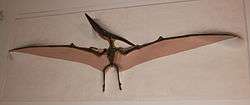Pteranodontia
| Pteranodontians Temporal range: Early Cretaceous - Late Cretaceous, 127–66 Ma | |
|---|---|
 | |
| Mounted skeleton Pteranodon longiceps | |
| | |
| Fossil specimen of Nyctosaurus gracilis | |
| Scientific classification | |
| Kingdom: | Animalia |
| Phylum: | Chordata |
| Order: | †Pterosauria |
| Suborder: | †Pterodactyloidea |
| Clade: | †Ornithocheiroidea |
| Clade: | †Pteranodontia Marsh, 1887 |
| Subgroups | |
| |
| Synonyms | |
|
Euornithocheira Unwin, 2003 | |
Pteranodontia is an extinct group of ornithocheiroid pterosaurs that lived from the Early Cretaceous to the Late Cretaceous (middle Barremian to middle Campanian stages) of Asia, Europe, North America and South America.[1]
Locomotion
Pteranodontians, like other pterosaurs, are considered to have been skilled fliers as well as adept at moving on the ground. Evidence from footprints shows that most pterosaurs did not sprawl their limbs to a large degree, as in modern reptiles, but rather held the limbs relatively erect when walking, like dinosaurs. While no pteranodontian footprints are known, it is likely that they also walked erect.[2] Among pterosaurs, pteranodontians had unusually uneven limb proportions, with the forelimbs much longer than the hind limbs. This would likely have required them to use unique modes of locomotion when on the ground compared to other pterosaurs. It is possible that pteranodontians ran (but not walked) bipedally, or that they used a hopping gait.[2] Pterosaur researcher Mike Habib has noted that the limbs proportions of pteranodontians like Anhanguera are consistent with hopping.[3]
Pteranodontians were among the last of the world's pterosaur faunas. The species Piksi barbarulna and a few potential pteranodontids and nyctosaurs have all been found dating from the Campanian to the Maastrichtian ages of the Late Cretaceous period.[4]
Classification
Pteranodontia was originally named by O.C. Marsh in 1876. In 2003, it was given a phylogenetic definition by David Unwin as the common ancestor of Pteranodon and Nyctosaurus plus all its descendants. Though Marsh had originally named this group based on the shared absence of teeth in those species, most analyses show that all of the traditional "ornithocheiroid" pterosaurs are also members of this clade.
In 2003, Alexander Wilhelm Armin Kellner defined the clade Pteranodontoidea as the last common ancestor of Anhanguera, Pteranodon and all its descendants. Ornithocheiroidea is sometimes considered to be the senior synonym of Pteranodontoidea, however its depends on it definition. Ornithocheiroidea was originally defined as an apomorphy-based taxon by Christopher Bennett in 1994. Later, Kellner (2003) redefined it to represent the node of Anhanguera, Pteranodon, Quetzalcoatlus and Dsungaripterus.[5] Later, David Unwin (2003) suggested a different definition, the node that contains Pteranodon longiceps and Istiodactylus latidens, thus making Pteranodontoidea a junior synonym of Ornithocheiroidea.[6] Brian Andres (2008, 2010, 2014) in his analyses, converts Ornithocheiroidea using the definition of Kellner (2003) to avoid this synonymy.[7]
Classification
Below is a cladogram showing the results of a phylogenetic analysis presented by Andres & Myers, 2014.[8]
| Ornithocheiroidea |
| |||||||||||||||||||||||||||
"Wyomingopteryx"
The name "Wyomingopteryx" appears in a painting of Morrison prehistoric animals by Robert Bakker. However, this binomen is a nomen nudum, and it is possible that Bakker may have intended to coin "Wyomingopteryx" for the Istiodactylus-like specimen TATE 5999 because that specimen is found in Wyoming.[9][10]
References
- ↑ Richard J. Butler; Stephen L. Brusatte; Brian B. Andres; Roger B. J. Benson (2012). "How do geological sampling biases affect studies of morphological evolution in deep time? A case study of the Pterosauria (Reptilia: Archosauria)". Evolution. 66 (1): 147–162. doi:10.1111/j.1558-5646.2011.01415.x.
- 1 2 Witton, M.P.; Habib, M.B. (2010). "On the Size and Flight Diversity of Giant Pterosaurs, the Use of Birds as Pterosaur Analogues and Comments on Pterosaur Flightlessness". PLoS ONE. 5 (11): e13982. PMC 2981443
 . PMID 21085624. doi:10.1371/journal.pone.0013982.
. PMID 21085624. doi:10.1371/journal.pone.0013982. - ↑ Habib, M. (2011). "Dinosaur Revolution: Anhanguera." H2VP: Paleobiomechanics. Weblog entry, 20-SEP-2011. Accessed 28-SEP-2011: http://h2vp.blogspot.com/2011/09/dinosaur-revolution-anhanguera.html
- ↑ Federico L. Agnolin & David Varricchio (2012). "Systematic reinterpretation of Piksi barbarulna Varricchio, 2002 from the Two Medicine Formation (Upper Cretaceous) of Western USA (Montana) as a pterosaur rather than a bird" (PDF). Geodiversitas. 34 (4): 883–894. doi:10.5252/g2012n4a10.
- ↑ Kellner, A. W. A., (2003): Pterosaur phylogeny and comments on the evolutionary history of the group. pp. 105-137. — in Buffetaut, E. & Mazin, J.-M., (eds.): Evolution and Palaeobiology of Pterosaurs. Geological Society of London, Special Publications 217, London, 1-347
- ↑ Unwin, D. M., (2003): On the phylogeny and evolutionary history of pterosaurs. pp. 139-190. — in Buffetaut, E. & Mazin, J.-M., (eds.): Evolution and Palaeobiology of Pterosaurs. Geological Society of London, Special Publications 217, London, 1-347
- ↑ Andres, Brian Blake (2014). Systematics of the Pterosauria. Yale University. p. 366. A preview that shows the cladogram without clade names
- ↑ Andres, B.; Clark, J.; Xu, X. (2014). "The Earliest Pterodactyloid and the Origin of the Group". Current Biology. 24: 1011–6. PMID 24768054. doi:10.1016/j.cub.2014.03.030.
- ↑ Bakker, R.T. (1994) Unearthing the Jurassic. In: Science Year 1995. World Book Inc.:Chicago, London, Sydney, Toronto, 76-89. ISBN 0-7166-0595-3.
- ↑ Bakker, R.T. (1998). "Dinosaur mid-life crisis: the Jurassic-Cretaceous transition in Wyoming and Colorado". In Lucas, Spencer G.; Kirkland, James I.; Estep, J.W. Lower and Middle Cretaceous Terrestrial Ecosystems 14. New Mexico Museum of Natural History and Science Bulletin. pp. 67–77.